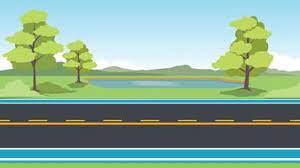A Creative Solution to Traffic Flow
Grade 7
Presentation
No video provided
Problem
People get stuck in traffic everyday, and lose a lot of important time.Our project is about making this wait slower, or even eliminating it completly. With this project and the data we collet, we may pottencialy be able to fix these problems and make everyones day more productive by spending less time at traffic lights.
Method
Method
The first step in our scientific method for improving traffic flow is to do background research. Background research is important in any science project, as we need to know what we are doing in order to execute it. We will background research “rules of the road” which to us means learning how to drive, not literally though, we just want to learn how to navigate intersections, and who has the right of in certain situations etc. We also want to do some background research on simulations, like how they work, and what kind of simulation we would need and finally, we need to find a simulation, and try and get access to people who can give us the simulation. With this simulation it. With this simulation, our background research is complete. Next, we will create our methods of traffic flow. Currently, as we have not done any background research, we are not sure what these methods will look like, but they may be something like changing the roads, or adding new types of traffic lights etc. Then, on our simulation, we will test our new methods and see if they do well or not. To us, “well” means that there are limited collisions and traffic moves smoothly. After this, we will conclude or information, as well as share our information, so if we have a better traffic flow method, we can share it to people who can help us make the change and improve traffic flow.
Background Research
An intersection in where 2 or more roads meet, often shaped like a “+” or a “T”. Intersections are where you would find traffic lights, of cross walks. Intersections can also be round, known as traffic circles and roundabouts. When entering an intersection and there is a yield sign, drivers must look for cars coming from other directions before continuing through the intersection. At a yield sign, drivers do not need to come to a complete stop, but at a stop sign, they do. At a stop sign, drivers must stop to look for other cars for 3 seconds. If the car does not stop, but slows down at a stop sign, this is known as a rolling stop, and you will be fined for completing one at a stop sign. At an intersection, where there is a stop sign, there may be a stop line. Stop lines show where you should stop at the intersection, and drivers should stop just before or on the stop line. If there is no stop line, then drivers are supposed to stop just before the marked cross walk. If there is no stop line or marked cross walk, then drivers are supposed to stop 3 meters before the intersection, without blocking the sidewalk. At an intersection, drivers need to know who has the right of way, which means who gets to go when. At a controlled intersection, which is an intersection with traffic lights, there will be a small road and a main road. Drivers on the small road which are not turning left must yield to drivers on the main road, as the drivers on the main road going forward or right will always have the right of way. When there are no drivers on the main road, the driver going forward or turning right on the small road now has the right of way to proceed forward, through the intersection. If a driver on the small road is turning left, they must wait until all cars turning right or going forward have passed before they have the right of way to proceed through the intersection. The same rules apply for drivers turning left on the main road, who have right of way when all cars have passed except for ones turning left. In an uncontrolled intersection, drivers can accept the same right of way rules, but pedestrians must wait for cars to let them pass. A simple method to remember how right of way works is: Main Road right/left, small road right/left main road left, small road left.
For our project, we needed a simulation. This simulation may be difficult to get, so we decided to email the University of Calgary’s civil engineering department and talk to them about what kind of simulations we could use. We would also like to ask them if they have any ideas on what could improve traffic flow and on what types of roads make faster and safer traffic flow. We emailed civil@ucalgary.ca, which is the email for the entire department, and gachari@ucalgary.ca, who is the head of the department.
Hello University of Calgary’s civil engineering department,
We are Carson Benoit and Carter Fech, (grade 7 students from STEM Innovation Academy) who are doing a science fair project together for the Calgary Youth Science Fair. Our project’s purpose is to improve traffic flow by making it safer and more efficient. We will do this by creating new ideas that could be used on roads, such as adding new signs or traffic lights, or coming up with different types of intersections. We are looking for ideas as to how we can test our methods. We were wondering if you have any ideas such as software products that we could access at the University of Calgary, and if you could demonstrate them and show us how it works. We were also wondering if somebody could talk to us about different ideas that we could use.
Thank you,
Carson Benoit and Carter Fech
After we had sent this message, a robot replied immediately giving us different emails to message depending on what type of message you are sending. The email that applied to us was engginfo@ucalgary.ca, so we sent the same message to that one. The next day ,Gopal Achari, the head of the University of Calgary’s civil engineering department messaged us, and said they would forward our message to Saeid Saidi, a civil engineering professor. Soon, they replied, and sent us a software called PTV vissim.
This software seemed very advanced, and more much more advanced civil engineers, and after some research, we realised this would be too difficult to learn. We later found a software called AnyLogic, which was a professional software, but was also basic to learn.
Intersections that will be Tested
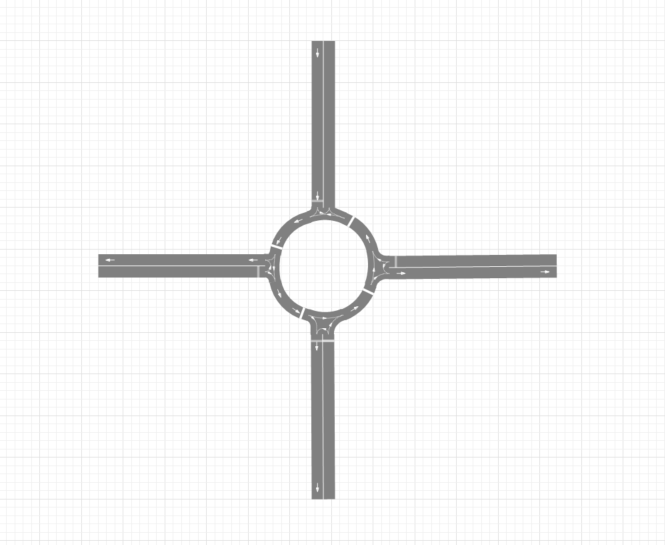
Roundabout
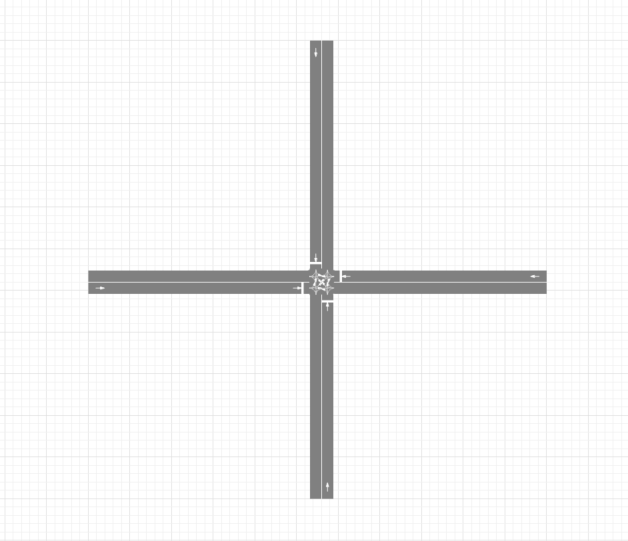
Four-Way
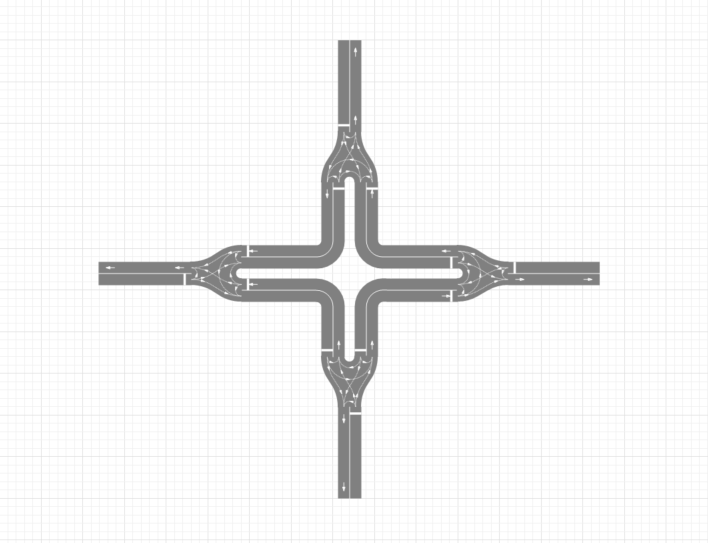
Turnin-RIght
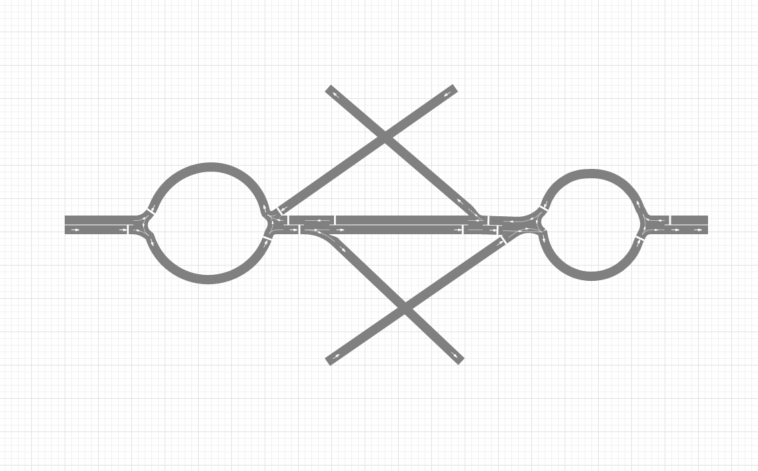
One-Direction Bowtie intersection
Analysis
Variables
Controlled:
Number of cars per hour (500, 150, and 1000)
Road leading to intersection (Each intersection will be 4 ways and will have a total length of 11 by 11 full squares. One-Direction Bowtie acceptation.).
Number of lanes on the road leading up to the intersection. (2)
Speed limit (60kph)
Number of exits/entrances. (4)
Length of cars: 5 miniature squares.
Manipulated:
Intersection/idea used.
Traffic light phases.
Hypothesis
For our experiment, we believe that the roundabout will do best in comparison to other intersections. It will work best for low amounts of cars and should still do excellent for higher amounts. We believe this because the roundabout has very minimal yielding. For higher amounts of cars per hour, the intersection will likely have some yielding, but not enough to cause problems and block traffic flow. The turning-right intersection will have major problems with larger amounts of cars, as it has more areas where cars meet, so they will yield at more points. But at lower amounts of cars, it should do fine because there will not be yielding. We believe this intersection will do best for lower amounts of cars. The regular four-way intersection will do worst, as there will almost always be yielding. The one-direction bowtie intersection will do better than the four-way intersection, but not extremely well as cars yield at the roundabouts, as there are multiple cars trying to enter the roundabout at once. We believe that this intersection will do best for higher amounts of cars. However, we hypothesize that the roundabout will do best for a medium amount of cars but will also do well for any amount of cars.
Data
Four-Way
|
Turn Right |
Turn Left |
Forward |
U-Turn |
|
16 |
16 |
14 |
18 |
Note that there were no traffic lights for this intersection. For this intersection, yielding happened very little, but if it did happen cars would be stuck for multiple seconds. The average time for this intersection was 16 seconds.
|
Turn Right |
Turn Left |
Forward |
U-Turn |
|
21 |
23 |
17 |
28 |
Cars yield very often for a very long time. The average time was 22.25.
|
Turn Right |
Turn Left |
Forward |
U-Turn |
|
18 |
22 |
9 |
56 |
Cars will yield very often for only a few seconds. The average time was 26.25
Turning Right Intersection
|
Turn Right |
Turn Left |
Forward |
U-Turn |
|
14 |
31 |
22 |
40 |
This intersection appeared to have no yielding, but cars struggled to complete U-turns. The average time was 26.75 seconds.
|
Turn Right |
Turn Left |
Forward |
U-Turn |
|
12 |
39 |
26 |
3:01 |
Cars moved very fast, but some would get stuck on U-turns and would take a very long to complete it. This resulted in a large buildup of cars, that would grow over time. The average time was 66.5 seconds.
|
Turn Right |
Turn Left |
Forward |
U-Turn |
|
26 |
36 |
30 |
∞ |
Whenever a car would attempt a U-turn, it would get stuck and be unable to complete it, resulting in major buildups. The average time was 273 seconds. (If U-turn was 1000 seconds.)
Roundabout
|
Turn Right |
Turn Left |
Forward |
U-Turn |
|
20 |
29 |
30 |
34 |
This intersection struggled a lot more than expected because it has a long path for the cars to travel compared to the Turning Right intersection. The average time was 25.75 seconds.
|
Turn Right |
Turn Left |
Forward |
U-Turn |
|
19 |
23 |
23 |
31 |
There did not seem to be much yielding, but there would have had to have been because moving forward took the same amount of time as turning left, even though left is a further distance. The average time was 24 seconds.
|
Turn Right |
Turn Left |
Forward |
U-Turn |
|
26 |
20 |
26 |
39 |
This intersection did very poorly compared to it on other amounts of cars per hour which makes sense, but it was a much bigger drop than expected. The average time was 27.75 seconds.
One-direcection bowtie intersection
|
|
Left |
Right |
Forward |
U-Turn |
|
Vertical |
38 |
15 |
32 |
53 |
|
Horizontal |
36 |
15 |
24 |
14 |
The average vertical time was 34.5 seconds. For horizontal it was 22.5. In total, the average time was 28.375 seconds.
|
|
Left |
Right |
Forward |
U-Turn |
|
Vertical |
42 |
15 |
38 |
48 |
|
Horizontal |
41 |
15 |
27 |
21 |
The average vertical time was 35.75 seconds. For horizontal it was 26 seconds. In total it was 30.375.
|
|
Left |
Right |
Forward |
U-Turn |
|
Vertical |
1:03 |
37 |
47 |
1:00 |
|
Horizontal |
27 |
59 |
22 |
22 |
The average vertical time was 48.83 seconds. For horizontal it was 32.5 seconds. In total it was 42.125.
Conclusion
These tests were used to create a new method for traffic flow and ended up just becoming intersections. This is because it would be impossible to change the rules of the roads. But making new intersections could be a great solution to improving traffic flow. Overall, the already existing roundabout did the best out of all the intersections. The roundabout is simple, and does not take many turns, and unless put in a bad place, can be a great intersection. The turning right intersection did best for 150 cars per hour, as it is very similar to the roundabout, but has a shorter path, so cars can move faster. The regular four-way intersection had the best quantitative data, but the numbers are not the only part of the experiment. Just watching the intersections can clearly show that one is better than another. This was the case for the regular for way intersection, as it could clearly be seen to be doing poorly for all amounts of cars per hour. For 150 cars per hour, the turning right intersection did best, followed by the roundabout, then the four-way intersection, and finally the one-direction bowtie intersection. For 500, it went roundabout, four-way, turning right, one-direction bowtie. It was similar for 1000 too, but the turning right intersection did worst. One of the intersections that we created did better than both of our currently existing intersections, so this could be important information. This was only for 150 cars per hour, and for all other amounts of cars per hour, the roundabout did best, so roundabout is the best intersection that we tested.
We learned that both current intersections are both very powerful, and there is no major need for new ones. Civil engineers will spend lifetimes on creating new intersections, and we were able to make a basic one that was capable of working. Next time, we would try to talk to real civil engineers, and hear their ideas on our intersections.
Citations
Know Traffic Sign Shape to Read Quickly
Road rules and safe driving. Alberta.ca. (n.d.). https://www.alberta.ca/road-rules-and-safe-driving
- Header image
Acknowledgement
AnyLogic simulation software (Specifically the trafiic modeling library.

